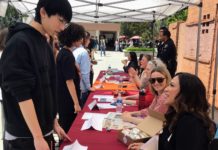South Pasadena police will no longer use the “carotid restraint control hold” as one of its authorized use of force techniques, the city said in a press release Monday June 8.
The announcement came hours after Police Chief Joe Ortiz gave news of the decision to the Pubic Safety Commission, saying it was “effective immediately.” The chief also reported no arrests in town this week of demonstrators, who are planning a protest at the start of the next City Council meeting Wednesday evening outside the Council chambers
According to the press release, Ortiz determined the technique, also known as a ‘sleeper hold,” should no longer be used and “will be removed” from the department’s policy manual.
The method is described as “rendering a person unconscious by restricting the flow of blood to the brain by compressing the sides of the neck where the carotid arteries are located.”
The sleeper hold is not the same as the method used by Minneapolis Police to kill George Floyd, during which the offending officer placed his knee on Floyd’s neck as he lay handcuffed on the ground.
Councilman Richard Schneider told the commission the decision was made Sunday, though it was unclear whether it came down from the Chief himself or in connection with a special closed session the city council held Sunday afternoon.
Since 2016, Ortiz said, SPPD has responded to 140,000 calls for service. In 38 of those cases, the use of force was deployed but in none was the carotid restraint used.
The “carotid restraint” is one of 11 “situational use of force options” SPPD officers have pursuant to Section 300.1.3 of the city’s very lengthy police policy manual. That section refers in particular to the “lateral vascular neck restraint” as an example of carotid restraint. The city’s press release did not clarify if it intends is to remove all or only some types of carotid restraint.

NOTE: Just a year ago the SPPD training CLICK HERE
“Police Officers must treat all people with as much respect and dignity as the situation allows,” according to a statement of “core values” on the police department’s website. “Even in a confrontational, adversarial encounter, officers must remain professional and respectful.”
Ortiz told the Commission that over the past few days, most cities in the San Gabriel Valley have scaled back from a “tactical deployment” to a “modified” tactical deployment.
He reported that one group of peaceful protesters has been present at Fair Oaks and Mission over the past week and that there have been three smaller peaceful protests elsewhere in town. No arrests were made.
SPPD officers twice a year receive “updates” in current arrest, control and firearms skills, the Chief also said. Arrest and firearm training are each done every two years. Officers have also attended separate training classes in “de-escalation.”
Ortiz also said Department policy addresses all eight categories of the policy solutions recommended by “Campaign Zero.”
The recently formed South Pasadena Youth for Police Reform, has been demanding South Pasadena discontinue use of the carotid restraint as one of 21 demands they have made for reform on training and recruiting, transparency and other topics including disclosure of misconduct by current officers who served in other police departments previously, more detailed information about the policy budget, elimination of the “10 pm curfew for juveniles” and others.
“We know all to well the deep-set structural changes necessary to prevent the tragedies that have gone without recourse in America and we ask that real change happens in response. The group is organizing a protest on the sidewalk outside City Council chambers prior to the Council’s next meeting Wednesday evening which includes a closed session, the group said, on “labor negotiations with the police union.”
According to the published agenda, the closed session is a conference with the Council’s labor negotiators—city manager Stephanie DeWolfe and Interim Human Resources manager Michael Casalou.
The group will demand “that the police budget not be increased until our proposals are met.” It encouraged participants to remain socially distanced and not block the public right of way.















.png)












“Since 2016, Ortiz said, SPPD has responded to 140,000 calls for service. In 38 of those cases, the use of force was deployed but in none was the carotid restraint used.”
Those are remarkable numbers. Our police department is using force well under ten times a year, during tens of thousands of annual interactions.
Has the SPPD ever had an in-custody death? It certainly hasn’t had one in recent memory.
The available evidence suggests pretty strongly that this simply isn’t a brutal police department. Similarly, when officers have been unprofessional or rude, as at the Cheney household, the chief has upheld discourtesy complaints rather than ignoring or denying a professional failure. I’m open to a different argument, if someone would like to make it, but that’s how it looks to me.
After the Vanessa Marquez shooting, there’s an argument to be made for better training in dealing with mental illness, and there’s always room for discussions about making policy — like the prompt release of body camera footage from critical incidents — but my clear impression is that we do not have a problem department. In the face of considerable anger and controversy, this seems like something to appreciate.